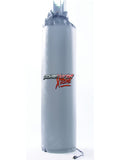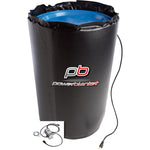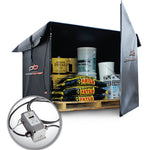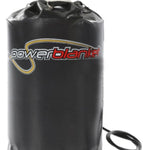You have no items in your shopping cart.
Article At-a-Glance
What is Weld Preheat and Why is it Essential in Welding?
Weld preheat involves heating the weld area to a specific temperature before welding to minimize distortion and cracking, reduce the risk of hydrogen-induced cracking, and ensure a strong, defect-free weld, especially in thick or crack-prone materials.
Key Takeaways
- Define Weld Preheat: Understand weld preheat as the process of heating the weld area to a specific temperature before welding to minimize distortion, reduce cracking risks, and ensure weld integrity, especially in thick or crack-prone materials.
- Identify When to Preheat: Recognize the need for preheating in scenarios involving thick materials, crack-prone metals, high heat input processes, V-groove joints, or cold weather conditions to prevent defects like cracking and porosity.
- Explore Preheat Methods: Learn about various preheat methods such as furnace, oven, radiant, and convection, each suited for different project sizes and material thicknesses, ensuring the right choice for your welding needs.
- Understand Preheat Benefits: Appreciate the benefits of preheating, including slowing the cooling rate to prevent martensite formation, reducing hydrogen cracking risk, improving weld ductility, and removing moisture from the base metal.
- Avoid Common Preheat Mistakes: Avoid issues like cracking, distortion, porosity, and incomplete fusion by adhering to proper preheat temperatures, monitoring the process, and ensuring a clean welding environment.
Weld Preheat: The Importance of Proper Temperature
Weld preheating is typically required for welding thick materials, materials that are prone to cracking, and materials that have been exposed to moisture. Read on to learn why preheating is more than just helpful when preparing to weld.

$1,460.00 USD
9" x 40" K Size Explosion-Proof Gas Cylinder Heater C1D2T4 (120V)
For reliable and efficient heating during the welding process, consider Heat Authority's tank and cylinder heaters. They provide direct, consistent heat, allowing you to maintain optimal container temperatures and improve cylinder performance.
What is weld preheat, and why is it important?
Weld preheat is heating the weld area to a specific temperature before welding. This is important because it helps to minimize distortion and cracking in the weld area. Preheat also helps to decrease the chance of hydrogen-induced cracking, a type of weld defect.
Our welding friends at Miller know the importance of weld preheat:
Avoid preheating too little or skipping this portion of the welding procedure. Preheating deters cracking, since it slows down the cooling rate after welding. The type and thickness of the material you are welding will determine preheat and interpass temperature. You can find these requirements in the WPS or welding codes.
What is the purpose of preheat?
Preheat provides the following benefits:
- Slows the cooling rate of the weld, which helps to prevent the formation of martensite, a hard and brittle microstructure.
- Reduces the risk of hydrogen cracking, which can occur when hydrogen is trapped in the weld metal.
- Improves the ductility of the weld metal, making it more resistant to cracking.
- Removes moisture from the base metal, which can cause porosity in the weld.

When determining preheat temperatures, consider factors such as base metal thickness and composition, welding process, and filler metal being used. Additionally, it’s essential to maintain the preheat temperature throughout the welding process and determine if post-weld heat treatment is necessary.
How do you know when to start preheating your weldment?
Not every weld needs a preheating treatment. However, there are signs that weld preheat is needed to help ensure a strong weld:
- The material is prone to cracking: Some materials, such as aluminum and magnesium, are more prone to cracking than others. These materials may require preheating to reduce the risk of cracking.
- The material is thick: Thicker materials require more preheating than thinner materials. This is because thicker materials cool more slowly, which increases the risk of cracking.
- You are using a welding process that produces a high heat input: Some welding processes, such as gas metal arc welding (GMAW), require more preheating than others. This is because GMAW produces a high heat input, which can cause the base metal to cool too quickly.
- You are welding a V-groove joint: The type of weld joint can also affect the need for preheating. For example, V-groove welds require more preheating than fillet welds.
- You are welding in cold weather: Welding in cold weather can increase the risk of cracking. In these cases, preheating may be required to bring the base metal up to a temperature that is within the recommended range.
If you notice any of these signs, it's best to preheat your weldment to prevent cracking.
What are the different types of weld preheat methods available, and which is best for your project?
There are several types of weld preheat methods available, including furnace, oven, radiant, and convection. Each has its benefits and drawbacks, so it is important to choose the right method for your project. Furnace preheating is the most common type and involves heating the entire weldment to a specific temperature. This is best suited for large projects with thick base metals. Oven preheating is similar to furnace preheating but is used for smaller projects with thinner base metals. Radiant preheating uses heat radiation to warm the weld area, while convection preheating uses a fan to circulate air around the weldment. These methods are best suited for smaller projects with thin base metals.
Safe weld preheat
Regardless of which type of preheating you choose, remember that safety is the number one priority of your welding environment. Heating in hazardous areas might mean choosing the safest option for weld preheat instead of the quickest or cheapest option. A low-danger workplace will also help you focus on proper preheating and the quality of your weld.

How do you properly apply weld preheat using each available method?
Furnace, oven, convection, and radiant preheating all have their benefits and drawbacks. Some methods are widely applicable in meeting weld preheat needs, while others are better for specific situations. No matter which one works best for you, it’s important to follow a few general rules to help you get the best weld. Additionally, learning about tank heating essentials will help you know the most effective way to preheat metal.
Here are some key tips for preheating when welding:
- Use a temperature-indicating crayon or paint to mark the area to be preheated. This will help you to ensure that the area is heated evenly.
- Preheat the entire area to be welded, not just the weld joint itself.
- Monitor the temperature of the workpiece during preheating. The temperature should not exceed the maximum preheat temperature specified for the material being welded.
- Allow the workpiece to cool slowly after preheating. This will help to prevent thermal shock.
What are some common problems associated with improper weld preheat, and how can you avoid them?
Even experienced welders can make mistakes. However, a proper weld preheat can help you avoid the following:
- Cracking: Improper preheat can lead to cracking in the weld, especially in materials that are prone to cracking, such as high-strength steels and aluminum. This is because the weld cools too quickly, which causes stresses in the weld metal and the heat-affected zone (HAZ). To avoid cracking, preheat the material to a predetermined temperature and maintain that specific temperature throughout the welding process.
- Distortion: Improper preheat can also lead to distortion of the weldment. This is due to the weld metal expanding as it cools, and if the material is not preheated, the expansion can cause the weldment to warp or bend. Distortion can be prevented by preheating the material evenly and using a welding process that produces minimal heat input.
- Porosity: Porosity is the presence of voids or holes in the weld metal. Porosity can be caused by a number of factors, including improper preheat, moisture in the base material, or contamination of the welding environment. Prevent porous welds by preheating the material to the correct temperature, using clean and dry filler metal, and welding in a clean environment.
- Incomplete fusion: Incomplete fusion occurs when the weld metal does not completely melt the base material. This can be caused by a number of factors, including improper preheat, too low of a welding current, or poor welding technique. To avoid incomplete fusion, preheat the material to a specified temperature and use the right welding current to ensure a proper weld.
It’s clear that weld preheat is critical for a strong, even weld. Maintaining proper temperatures will help you with your weld preheat and other parts of the welding process. Tank and gas cylinder heaters provide direct, consistent heat, allowing welders like you to move forward in your welding process with confidence.














